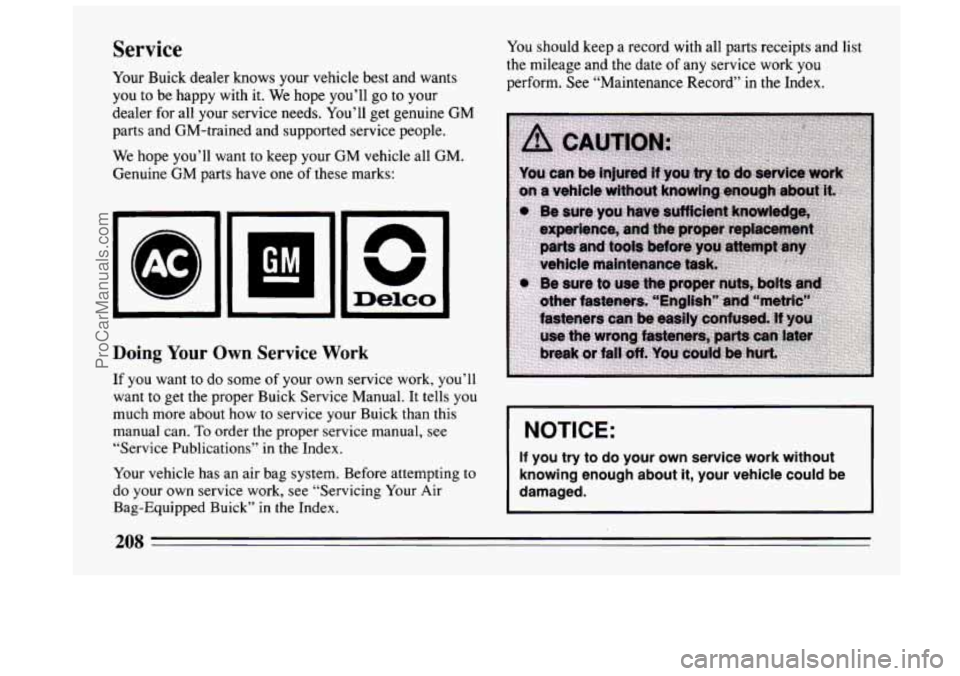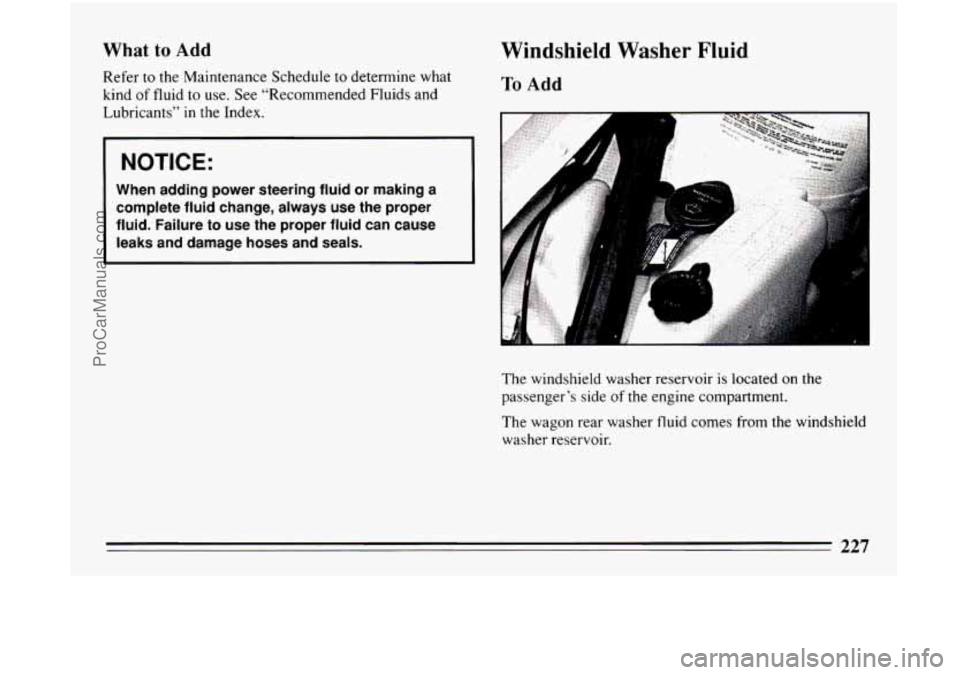1994 BUICK CENTURY maintenance
[x] Cancel search: maintenancePage 11 of 308

@ Table of Contents
How to Use this Manual ................................................................ 10
This part tells you how to use your manual and includes safet\
y and vehicle damage warnings and symbols.
Seats and Restraint Systems ............................................................. 13
This part tells you how to use your seats and safety belts p\
roperly. It also explains the “SRS” system.
This part explains how
to start and operate your Buick.
This part tells you how to adjust the ventilation and comfort \
controls and how to operate your sound system.
YourDrivingandtheRoad .............................................................. 139
Here you’ll find helpful information and tips about the road\
and how to drive under different conditions.
ProblemsontheRoad .................................................................. 171
This part tells you what to do if you have a problem while driving, such as a flat tire or engine
overheating, etc.
Here the manual tells you how to keep your Buick running prop\
erly and looking good.
This part tells you when to perform vehicle maintenance and wh\
at fluids and lubricants to use.
This part tells you how to contact Buick for assistance and h\
ow
to get service publications. It also
gives
you information on “Reporting Safety Defects” on page 283.
Here’s an alphabetical listing of almost every subject in this manual. You can use it to quickly find
something
you want to read.
FeaturesandControls .................................................................. 65
Comfort Controls and Audio Systems ..................................................... 121
ServiceandAppearanceCare ............................................................ 207
Maintenanceschedule .................................................................. 261
Customer Assistance Information
........................................................ 281
Index
........................................................................\
........ 291
7
ProCarManuals.com
Page 43 of 308

0 Let only qualified technicians work on your air bag
system. Improper service can mean that your air bag
system won’t work properly. See your dealer for
service.
NOTICE:
If you damage the cover for the driver’s air bag, it
may not work properly. You may have to replace
the air bag on the steering wheel.
Do not open or
break the air bag cover.
Is the smoke from an air bag inflation harmful?
The particles emitted during air bag inflation are not
harmful to most people. Some people with respiratory
ailments may experience difficulty breathing if they stay
in the vehicle with the windows closed after air bag
inflation.
So, if your air bag inflates, you and any
passengers should exit the vehicle if and when it is safe
to
do so. If you or your passengers can’t get out of the
vehicle, try
to get fresh air by opening a window,
turning on the fan, or opening a door.
Servicing Your Air Bag Equipped Buick
The air bag affects how your Buick should be serviced.
There are parts
of the air bag system in several places
around your vehicle. You don’t want the system to
inflate while someone is working on your vehicle. The
air bag system does not need regular maintenance. Your
Buick dealer and the
1994 Century Service Manual have
information about servicing your vehicle and the air bag
system. The air bag system does not need regular
maintenance.
41
ProCarManuals.com
Page 172 of 308

Parking on Hills
You really should not park your vehicle, with a trailer
attached, on
a hill. If something goes wrong, your rig
could
start to move. People can be injured, and both
your,vehicle and the trailer can be damaged.
But if
you ever have to park your rig on a hill, here’s
how to do it:
1. Apply your regular brakes, but don’t shift into
“P”
(Park) yet.
2. Have someone place chocks under the trailer wheels.
3. When the wheel chocks are in place, release the
regular brakes until the chocks absorb
the load.
4. Reapply the regular brakes. Then, apply your
parking brake, and then shift to
“P” (Park).
5. Release the regular brakes.
When You Are Ready to Leave After
Parking on a Hill
1. Apply your regular brakes and hold the pedal down
while you:
Start your engine;
Shift into a gear; and
Release the parking brake.
2. Let up on the brake pedal.
3. Drive slowly until the trailer is clear of the chocks.
4. Stop and have someone pick up and store the chocks.
Maintenance When Trailer Towing
Your vehicle will need service more often when you’re
pulling a trailer. See the Maintenance Schedule for more
on this. Things that are especially important in trailer
operation are automatic transaxle fluid (don’t overfill),
engine oil, belt, cooling system, and brake adjustment.
Each of these
is covered in this manual, and the Index
will help
you find them quickly. If you’re trailering, it’s
a good idea to review these sections before you start
your trip.
Check periodically to see that all hitch nuts and bolts are
tight.
170
ProCarManuals.com
Page 210 of 308

Service
Your Buick dealer knows your vehicle best and wants
you to be happy with it. We hope you’ll
go to your
dealer for all your service needs. You’ll get genuine GM
parts and GM-trained and supported service people.
We hope you’ll want
to keep your GM vehicle all GM.
Genuine GM parts have one
of these marks:
Doing Your Own Service Work
If you want to do some of your own service work, you’ll
want to get the proper Buick Service Manual. It tells you
much more about
how to service your Buick than this
manual can.
To order the proper service manual, see
“Service Publications” in the Index.
Your vehicle has an air bag system. Before attempting to
do your own service work, see “Servicing Your Air
Bag-Equipped Buick”
in the Index. You
should keep a record with all parts receipts and list
the mileage and the date
of any service work you
perform. See “Maintenance Record” in the Index.
NOTICE:
If you try to do your own service work without
knowing enough about it, your vehicle could be
damaged.
208
ProCarManuals.com
Page 221 of 308

Remove the wing nut and pull off the cover. Remove and replace the filter. Replace the cover,
wing
nut and rubber duct. Tighten the hose clamp.
Refer to the Maintenance Schedule to determine when
to replace the air filter.
See “Scheduled Maintenance Services’’
in the Index.
219
ProCarManuals.com
Page 222 of 308

I NOTICE:
If the air cleaner is off, a backfire can cause a
damaging engine fire.
And, dirt can easily get
into your engine, which will damage
it. Always
have the air cleaner
in place when you’re driving.
Automatic Transaxle Fluid
When to Check and Change
A good time to check your automatic transaxle fluid
level
is when the engine oil is changed. Refer to the
Maintenance Schedule to determine when to change
your fluid. See “Scheduled Maintenance Services” in
the Index.
How to Check
Because this operation can be a little difficult, you may
choose to have this done at a Buick dealership Service
Department.
If you do it yourself, be sure to follow all the
instructions here, or you could get a false reading on the
dipstick.
I NOTICE:
loo much or too little fluid can damage your
transaxle.
Too much can mean that some of the
fluid could come
out and fall on hot engine parts
or exhaust system, starting a fire. Be sure to get
an accurate reading
if you check your transaxle
fluid.
220
ProCarManuals.com
Page 225 of 308

How to Add Fluid
Refer to the Maintenance Schedule to determine what
kind of transaxle fluid
to use. See “Recommended
Fluids and Lubricants” in the Index.
Engine Coolant
If the fluid level is low, add only enough of the proper
fluid to bring the level into the cross-hatched area on the
dipstick.
1. Pull
out the dipstick.
2. Using a long-neck funnel, add enough fluid at the
It doesn’t take much fluid, generally less than a pint
(OSL).
Don’t overfill. We recommend you use only
fluid labeled DEXRON@-I11 or DEXRON@-IIE,
because fluids with that label are made especially for
your automatic transaxle. Damage caused by fluid other
than DEXRON@-I11 or DEXRON@-IIE is
not covered
by your new vehicle warranty. dipstick
hole
to bring it to the proper level.
After adding fluid, recheck the fluid level as
described under “How to Check.”
0 When the correct fluid level is obtained, push the
dipstick back in all the way. The following explains
your cooling system and how to
add coolant when it is low. If you have a problem with
engine overheating or if
you need to add coolant to your
radiator, see “Engine Overheating” in the Index.
The proper coolant for your Buick will:
0 Give freezing protection down to -34°F (-37°C).
0 Give boiling protection up to 262 “F ( 128 “C).
0 Protect against rust and corrosion.
Help keep the proper engine temperature.
0 Let the warning lights work as they should.
What to Use
Use a mixture of one-half clean water (preferably
distilled) and one-half antifreeze that meets “GM
Specification 1825-M,” which won’t damage aluminum
parts.
You can also use a recycled coolant conforming to
GM Specification 1825-M with a complete coolant flush
and refill. If you use this mixture,
you don’t need to add
anything else.
223
ProCarManuals.com
Page 229 of 308

What to Add
Refer to the Maintenance Schedule to determine what
kind
of fluid to use. See “Recommended Fluids and
Lubricants” in the Index.
NOTICE:
When adding power steering fluid or making a
complete fluid change, always use the proper
fluid. Failure to use the proper fluid can cause
leaks and damage hoses and seals.
Windshield Washer Fluid
To Add
- a
The windshield washer reservoir is located on the
passenger’s side
of the engine compartment.
The wagon rear washer fluid comes from the windshield
washer reservoir.
227
ProCarManuals.com